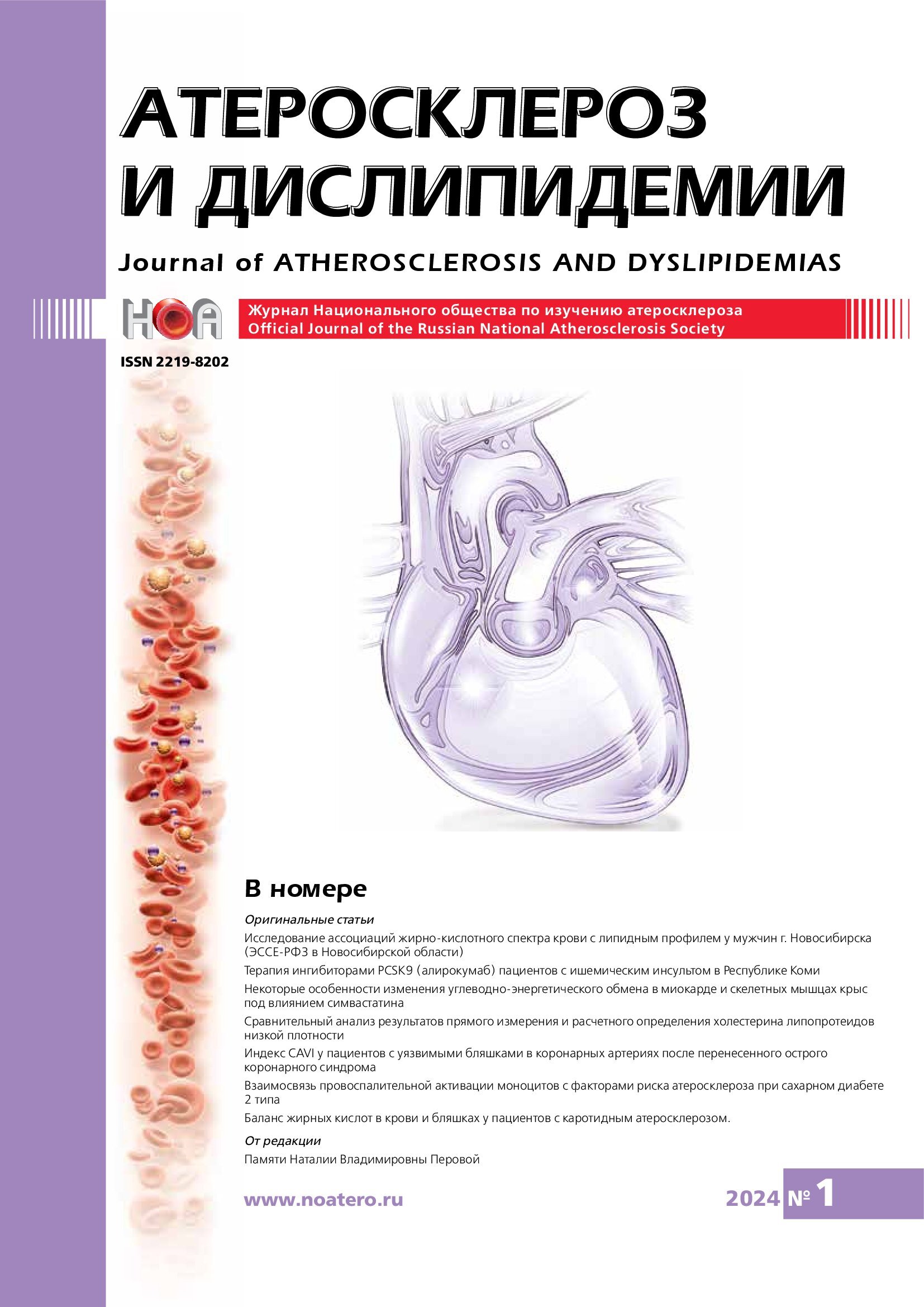Comparative analysis of the results of direct measurement against calculated determination of low-density lipoprotein cholesterol
DOI:
https://doi.org/10.34687/2219-8202.JAD.2024.01.0004Keywords:
low-density lipoprotein cholesterol, Friedwald formula, Blend-Altman methodAbstract
Aim. The aim of this study was to evaluate the impact of the results of the low-density lipoprotein cholesterol determination, obtained by direct and calculated methods according to Friedwald, on the classification of patients into hypercholesterolemia severity groups.
Materials and methods. The analysis of 161,051 results of lipid profile studies performed in a large centralized laboratory, excluding interventions. Statistical data processing was carried out using regression analysis and the Blend-Altman method.
Results. Regression analysis showed a high degree of relationship (R2=0.91) between the results of low-density lipoprotein cholesterol, obtained by a direct method and calculated by the Friedwald formula. However, the revealed trend (the slope of the regression line and the straight line in the Blend-Altman analysis) showed that below 3.5 mmol /l LDL-C for the direct method, in general, higher values are characteristic, compared with the Friedwald method, and above 3.5 mmol /l – lower.
Conclusion. For all ranges of LDL-C levels, differences in the classification of patients according to the values of direct determination and calculated values did not exceed 3.2%, which can be considered as a direct confirmation of the clinical validity of the Friedwald formula.
Downloads
References
Jesse R. L. On the relative value of an assay versus that of a test: a history of troponin for the diagnosis of myocardial infarction //Journal of the American College of Cardiology. – 2010. – Т. 55. – №. 19. – С. 2125-2128.
Castelli W. P. Cholesterol and lipids in the risk of coronary artery disease--the Framingham Heart Study //The Canadian journal of cardiology. – 1988. – Т. 4. – С. 5A-10A.
Friedewald W. T., Levy R. I., Fredrickson D. S. Estimation of the concentration of low-density lipoprotein cholesterol in plasma, without use of the preparative ultracentrifuge //Clinical chemistry. – 1972. – Т. 18. – №. 6. – С. 499-502.Martin S. S. et al. Comparison of low-density lipoprotein cholesterol assessment by Martin/Hopkins estimation, Friedewald estimation, and preparative ultracentrifugation: insights from the FOURIER trial //JAMA cardiology. – 2018. – Т. 3. – №. 8. – С. 749-753.
Martin S. S. et al. Comparison of low-density lipoprotein cholesterol assessment by Martin/Hopkins estimation, Friedewald estimation, and preparative ultracentrifugation insights from the FOURIER trial. JAMA Cardiol. 2018; 3: 749–53. – 2018.
Кухарчук В. В. и др. Диагностика и коррекция нарушений липидного обмена с целью профилактики и лечения атеросклероза. Российские рекомендации, VII пересмотр //Атеросклероз и дислипидемии. – 2020. – №. 1. – С. 7-40.
Садовников П. С., Ольховик А. Ю., Гуревич В. С. Расчетный метод определения уровня холестерина липопротеинов низкой плотности на основании современной парадигмы метаболизма липидов //Атеросклероз и дислипидемии. – 2022. – №. 3. – С. 21-28.
Langlois M. R. et al. Quantifying atherogenic lipoproteins for lipid-lowering strategies: consensus-based recommendations from EAS and EFLM //Clinical Chemistry and Laboratory Medicine (CCLM). – 2020. – Т. 58. – №. 4. – С. 496-517.
Cleeman J. I., Lenfant C. The national cholesterol education program: progress and prospects //Jama. – 1998. – Т. 280. – №. 24. – С. 2099-2104.
Островский О. В. и др. Изменение порогов принятия клинических решений в связи с внедрением в лабораторную практику прямого определения холестерина липопротеинов низкой плотности //Клиническая лабораторная диагностика. – 2012. – №. 2. – С. 13-15.
Nordestgaard B. G. et al. Fasting is not routinely required for determination of a lipid profile: clinical and laboratory implications including flagging at desirable concentration cut-points—a joint consensus statement from the European Atherosclerosis Society and European Federation of Clinical Chemistry and Laboratory Medicine //European heart journal. – 2016. – Т. 37. – №. 25. – С. 1944-1958
Downloads
Published
How to Cite
Issue
Section
License
Copyright (c) 2024 В. Е. Веровский, О. В. Островский, А. А. Панина, Е. А. Няхина, И. Г. Шушкова

This work is licensed under a Creative Commons Attribution 4.0 International License.























